
Nano Res.│武漢理工大學謝毅教授:具有梯度和多級結構的高耐候超雙疏防污閃涂層材料
背景介紹
室溫硫化硅橡膠(RTV)已被廣泛應用于高壓絕緣子防污閃,然而RTV表面的疏水特性易遭受破壞,當RTV表面上形成水滴,會導致氣-液-固邊界處的電場增強,電暈放電導致疏水性降低。疏水性的減弱會降低絕緣表面抑制漏電流和局部放電的能力,從而容易發生閃絡事故。近年來,超疏水(SH)材料被認為是傳統RTV的一種最有前途的替代材料,可有效提高絕緣子的防污閃性能。在絕緣子表面涂覆超疏水材料,由于其具有超強的拒水能力,可有效防止水粘附在器件表面,賦予絕緣子表面較大的漏電距離,抑制泄露電流,降低閃絡的可能性。然而考慮到材料在實際使用過程中,自然界存在的一些污穢物如鳥糞等含有有機污染物。這些有機物容易附著在超疏水絕緣子表面,從而導致可溶性鹽類和水的集聚,削弱其污閃性能。
鑒于此,武漢理工大學與倫敦大學學院、華中科技大學等合作,提出了一種具有獨特梯度結構的耐久性超疏水超疏油(超雙疏)涂層的制備方法并應用于電力設備防污閃領域,由于其優異的拒水拒油性能,在實際使用過程中涂層不會受到自然界中有機污穢物的影響,從而有效提高了高壓輸電線路絕緣子的防污閃性能。
研究方法
本研究超雙疏材料的制備采用噴涂“底漆+面漆”的工藝,通過控制噴涂壓力、噴涂距離等獲得具有獨特梯度結構的超雙疏(SAP)涂層。材料的表面形貌、微觀結構、表面結構、化學成分等采用SEM、TEM、EDS、FTIR等進行測試分析。采用砂紙打磨的方法測試材料的耐磨性,采用紫外光照、酸堿液浸泡、低溫冷凍及高溫退火等方法對材料的耐紫外穩定性、耐化學穩定性及耐高溫低溫穩定性。各種涂層絕緣子(如超疏水、超雙疏及RTV 涂層玻璃絕緣子)的污閃試驗是在人工污閃試驗臺上進行,在施加電壓之前,絕緣子表面采用人工污穢物(硅藻土和NaCl的混合物)進行污染,并在加濕器的霧室中完全暴露于飽和水蒸汽中15分鐘后取出置于污閃試驗臺進行試驗;通過逐漸升壓直到發生閃絡,并記錄閃絡電壓值。
成果簡介
(1)發展了一種具有獨特梯度結構的超雙疏材料設計及其構筑方法,該梯度結構的構筑有效提高了超雙疏涂層材料的耐磨性能。
(2)提出了一種新的污閃性能評估模型,該模型考慮了有機物污染對設備防污閃性能的影響,并通過絕緣子污閃試驗進行了驗證。研究表明,當超疏水絕緣子表面被有機物污染后,其污閃電壓降低,即防污閃性能下降。而超雙疏絕緣子在相同條件下污閃性能基本不受影響。
(3)發展了一種采用超雙疏涂層材料提高輸電線路用絕緣子的污閃性能的方法,其防污閃性能遠優于傳統RTV。在輕度和重度污染等級下,創制的超雙疏絕緣子的污閃電壓比傳統RTV絕緣子在相同條件下分別提高了29.0% 和42.9%。
圖文導讀
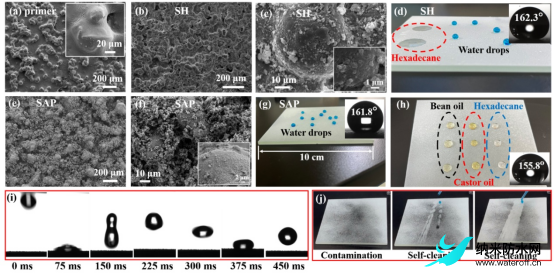
Figure 1 (a) SEM images of the primer showing mastoid morphologies of the surface. (b) and (c) SEM images of the SH coating displaying hierarchical micro-nanostructure of the surface. (d) The surface superhydrophobicity of SH coating enables the spherical water droplets (dyed with methyl blue) resident on top, while oil drops completely spread on the surface. (e) and (f) SEM images of the SAP coating surface showing hierarchical micro-nanostructure. (g) and (h) The superoleophobicity and superhydrophobicity of the SAP coating enable the spherical dyed water droplets and organic droplets (e.g., bean oil, hexadecane, and castor oil) resident on top. Insets in panels ((a), (c), and (f)) provide the high-magnification SEM images of the corresponding surface. Insets in panels ((d) and (g)) provide the optical images of the resident water droplets on the corresponding coating when measuring WCA. Inset in panel (h) reports the optical image of the hexadecane droplets on the corresponding coating when measuring OCA. (i) Water droplet (5 μL in volume) pinning and re-bouncing behaviour when released from a height of 2.5 mm toward the SAP surface. (j) Dropping dyed water on the fly-ash-contaminated SAP coating to display the self-cleaning performance of the SAP surface.

Figure 2 (a) The scheme illustrating the sandpaper abrasion test. (b) and (c) Evolution of WCA and WRA (b), and OCA and OSA (c) on the SAP coatings over sandpaper abrasion cycles. The oil for OCA and OSA tests is pump oil. (d)–(g) SEM images of SAP coatings after sandpaper abrasion test for 200 cycles ((d) and (e)), and 700 cycles ((f) and (g)), respectively. (h) The mechanism on persistence of superamphiphobicity upon sandpaper abrasion.
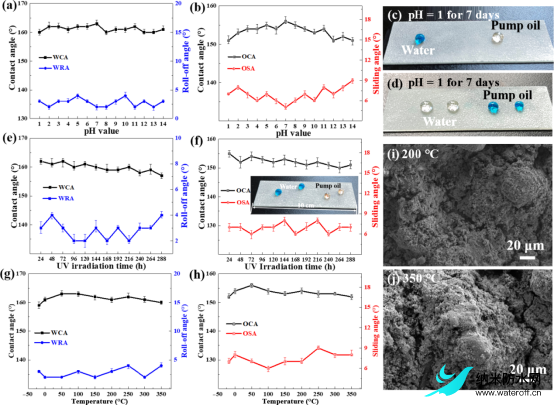
Figure 3 Chemical stability ((a)–(d)), UV irradiation stability ((e) and (f)), and thermal stability ((g)–(j)) of the SAP coating. (a) and (b) The evolution of WCA, and WRA (a) and OCA, and OSA (b) of the coated SAP glass slides after having been soaked in solutions of different pH values for 168 h. (c) and (d) Digital photographs displaying that both water and pump oil droplets preserve sphere-like shape on the coatings collected after submersion in extreme corrosion solutions (e.g., pH = 1 and pH = 14 solutions, respectively) for 168 h. (e) and (f) The evolution of WCA, and WRA (e) and OCA, and OSA (f) of the coated SAP glass slides over UV irradiation time. Inset in panel (f) shows the digital photograph of the coating together with water and pump oil droplets after 288 h of UV irradiation. (g) and (h) WCA, and WRA (g) and OCA, and OSA (h) of SAP coating treated at different temperatures for 2 h. (i) and (j) SEM images of the SAP coatings treated at 200 and 350 °C, respectively, for 2 h.
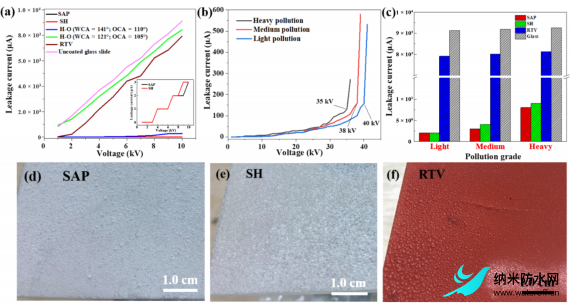
Figure 4 (a) Experimental measurement curves of leakage current and DC voltage of the various coatings under light pollution environment. Inset provides the enlarge view of the curve regarding SAP and SH coatings. (b) Experimental measurement curves of leakage current and DC voltage of the SAP coating under three levels, namely heavy, medium, and light contamination. (c) The column chart of leakage currents of various specimens as dictated under 10 kV of DC voltage and heavy, medium, and light pollution environment, respectively. (d)–(f) Digital photographs of SAP (d), SH (e), and RTV (f) coatings after contamination by diatomite powders and wetting in the fog chamber.
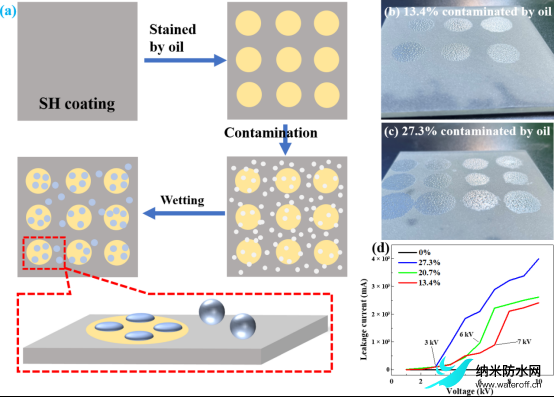
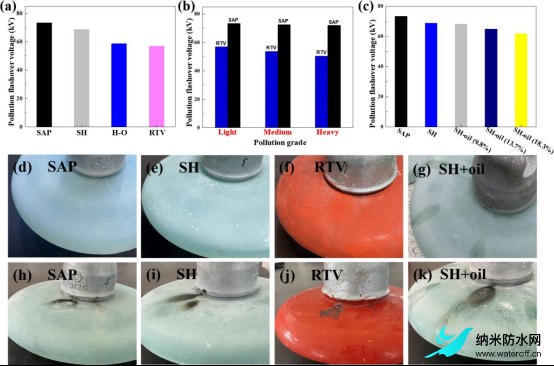
作者簡介
武漢理工大學謝毅教授團隊長期從事能源與環境功能納米材料領域的研究工作,主要致力于半導體納米晶和納米結構合成及其化學轉換、材料表界面修飾及功能薄膜材料(如超浸潤薄膜)制備、基于表面等離子體共振的光熱轉換材料(金屬硫族化合物、MXene等)制備及其上述材料在新能源、發光、光催化、自清潔、電力防污閃、防冰除冰、海水淡化等領域的應用研究,并取得了一系列標志性成果。研究成果發表于J. Am. Chem. Soc., ACS Nano, Chem. Mater., Nano Res., ACS Appl. Mater. Interfaces, Nanoscale, J. Colloid. Interf. Sci.等國內外重要學術刊物上。
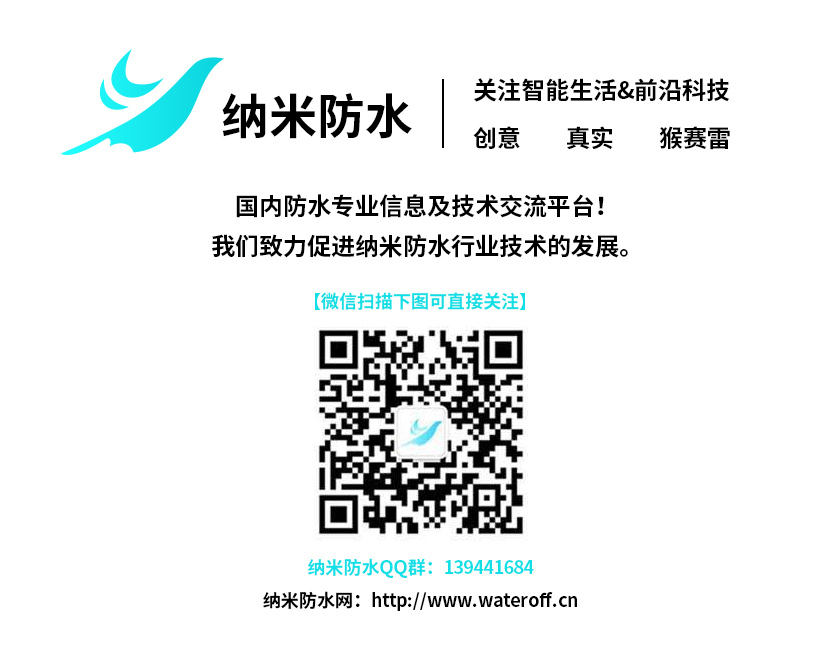
隨著電子產品防水需求的不斷提高,從原先的 IP54到現在的IP67IP68等級!市場上出現了防水透氣膜和防水透音膜,目前這兩種不同的材料應用被搞混了,今天便與大家一起討論防水透氣
最近各地降雨量激增,所以手機就難免會沾點水,作為生活中不可或缺的電子產品,防水已經成為一個十分重要重要功能,而且個人對目前的IP68手機市場是相當不滿意的。為什么?太貴
自然界中荷葉具有出淤泥而不染的典型不沾水特性(學術上稱為Cassie-Baxter狀態),具有自清潔、抗結冰、減阻、抗腐蝕等廣泛應用價值,而玫瑰花瓣則具有水滴高粘附特性(稱為Wenze
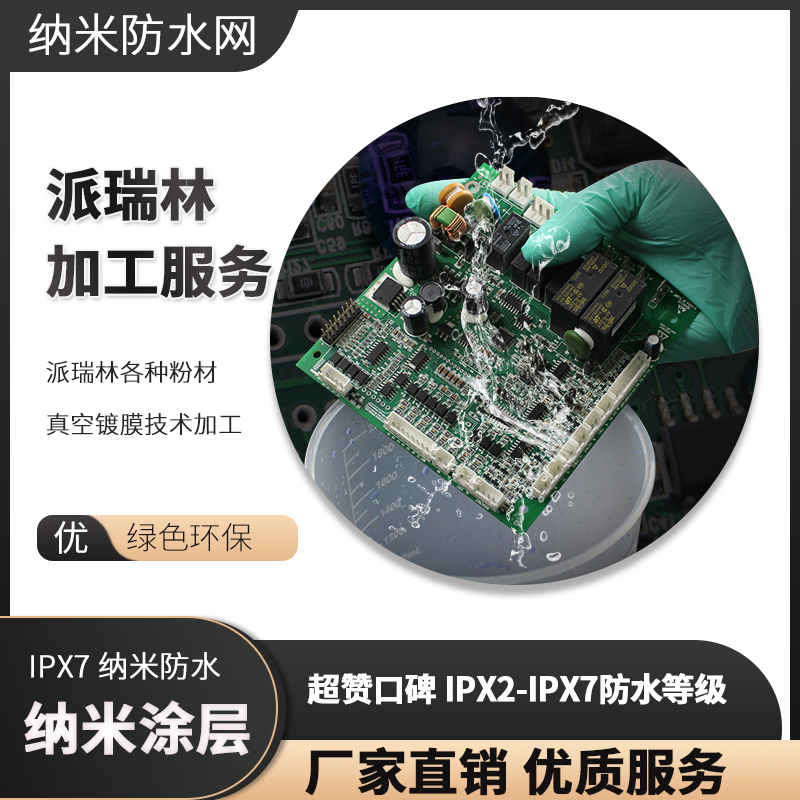
派瑞林各種粉材真空鍍膜技術加工 納米涂層防水處理
派瑞林各種粉材真空鍍膜技術加工 納米涂層防水處理
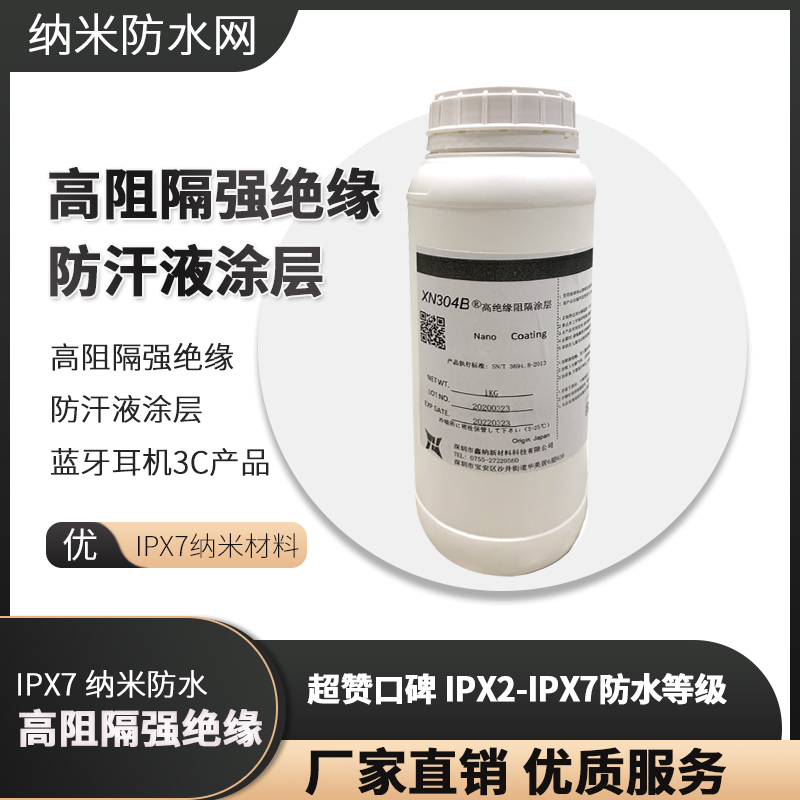
高阻隔強絕緣防汗液涂層藍牙耳機3C電子產品IPX7納米材料
高阻隔強絕緣防汗液涂層藍牙耳機3C電子產品IPX7納米材料
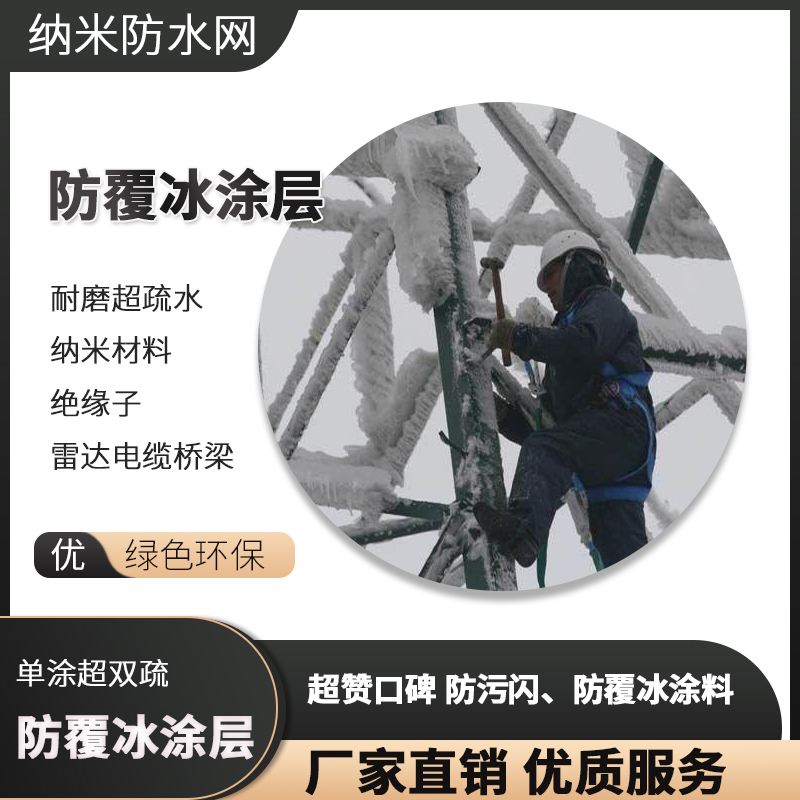
耐磨超疏水納米材料 絕緣子架空導線電纜橋梁防覆冰涂層
耐磨超疏水納米材料 絕緣子架空導線電纜橋梁防覆冰涂層
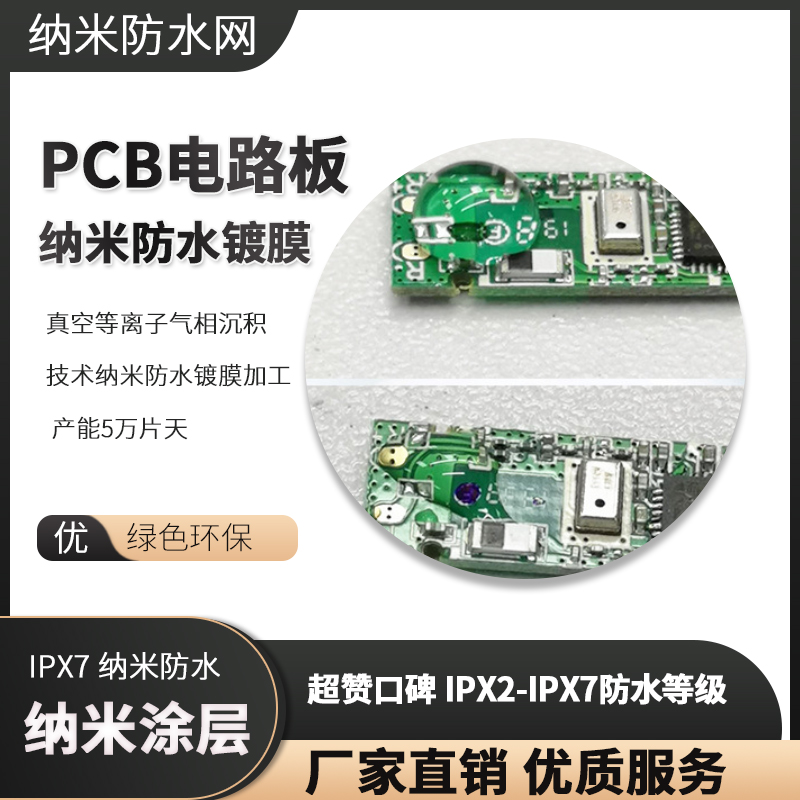
真空等離子氣相沉積技術納米防水鍍膜加工 產能5萬片天
真空等離子氣相沉積技術納米防水鍍膜加工 產能5萬片天
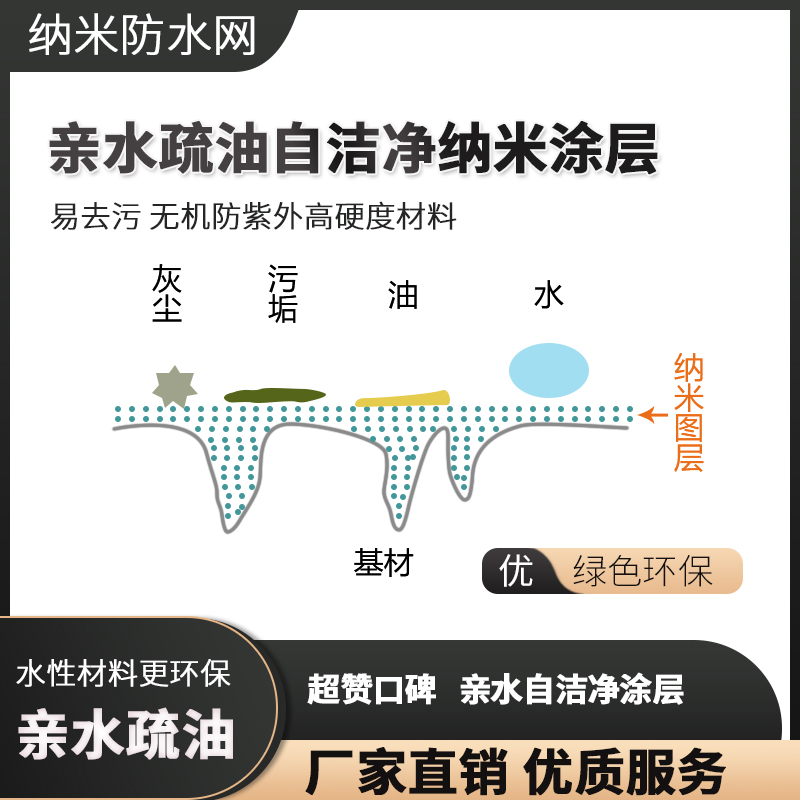
親水疏油自潔凈納米涂層 易去污 無機防紫外高硬度材料
親水疏油自潔凈納米涂層 易去污 無機防紫外高硬度材料
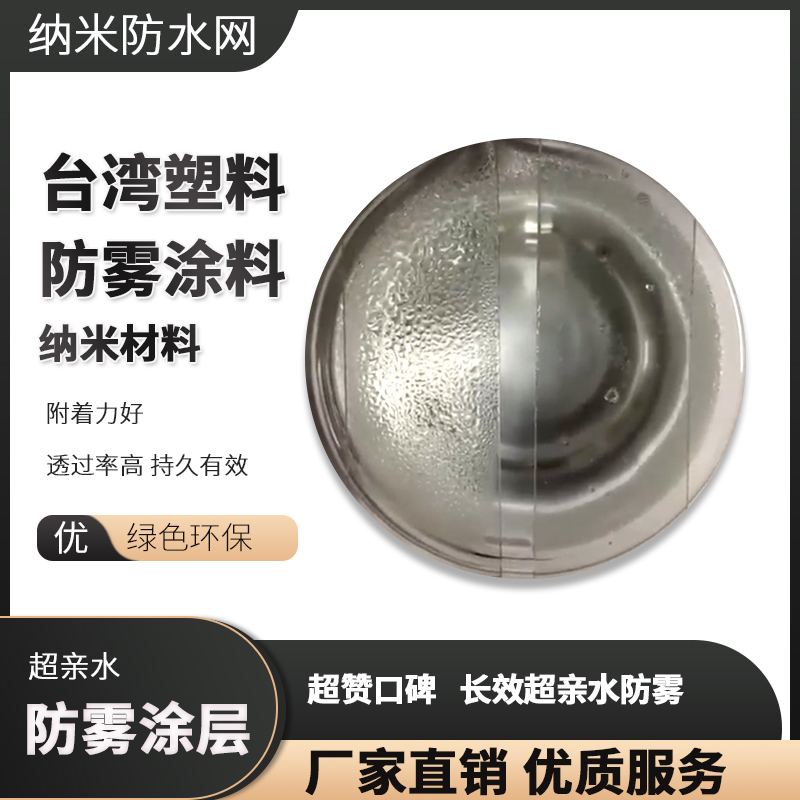
臺灣超親水防霧塑料專用 附著力好 透過率高 持久有效
臺灣超親水防霧塑料專用 附著力好 透過率高 持久有效

